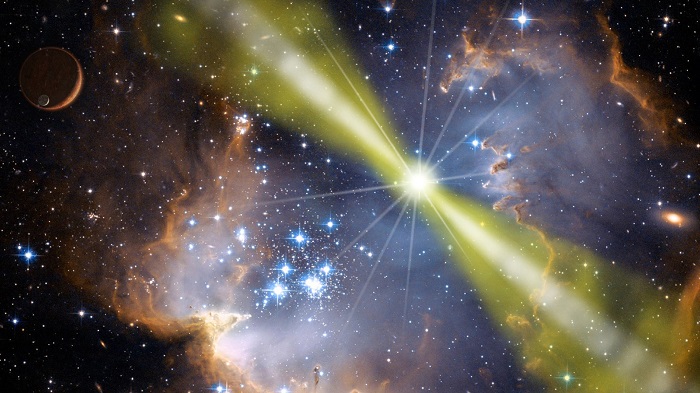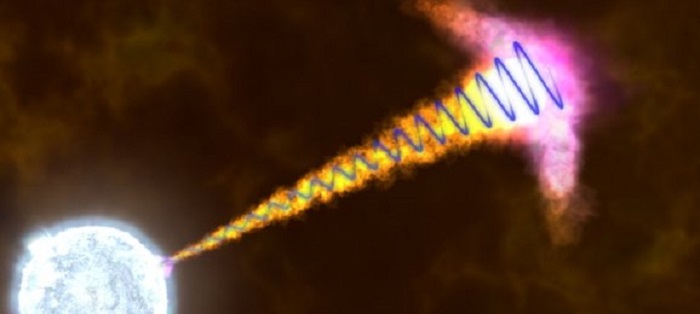.
1.05.2014

Gamma-ray burst 121024A, as seen on the day of burst by ESO's Very Large Telescope (VLT) in Chile. Only a week later the source had faded completely. Credit: Dr Klaas Wiersema, University of Leicester, UK and Dr Peter Curran, ICRAR.
.
For the first time an international team of astronomers has measured circular polarisation in the bright flash of light from a dying star collapsing to a black hole, giving insight into an event that happened almost 11 billion years ago.
Dr Peter Curran from the Curtin University node of the International Centre for Radio Astronomy Research (ICRAR) was part of the team that observed Gamma-ray Burst 121024A – a bright flash of light emitted by a dying star collapsing to a black hole – and found a surprising detail in the light they collected.
The research was published today in the prestigious journal Nature.
“Gamma-ray Bursts are so powerful that we can see them clearly at extraordinary distances,” Dr Curran said.
“But this one was an unusual case, its light had a strange feature – it was circularly polarised.”
If light is polarised it means the waves are moving in a uniform way as they travel – either bouncing up and down or left and right for linear polarisation, or in the case of circular polarisation, corkscrewing around in a spiral motion.
Dr Curran said 3D movies make use of circular polarisation by feeding a different image to each eye through special glasses, giving the illusion of depth while watching a film.
“Most light in the natural world is unpolarised, the waves are bouncing around at random,” he said.
“But the light from this Gamma-ray Burst looked like it was part of a 3D movie – it was about 1000 times more polarised than we expected.
“This means that the assumptions we’ve been making about Gamma-ray Bursts need to be completely reconsidered – assumptions of how electrons are accelerated to the incredible speeds we observe.
“Our results show that Gamma-ray Bursts are far more complex than we thought.”Gamma-ray Bursts are the brightest objects in the entire Universe, only lasting a fraction of a second, but sending out as much energy in that time as the Sun will in its entire life.
These bursts are emitted by dying stars collapsing to black holes that form jets of material travelling at over 99.995 per cent of the speed of light.
“These extreme objects are like super-powered versions of the world’s largest and most powerful particle accelerator, the Large Hadron Collider, except very far away in space,” Dr Curran said.
“We can use them to study microscopic electrons and how they behave in extreme environments, at a great distance – in this case, 18,500 million light years away, at a time when the Universe was just a fraction of its current age.
“This is the first time we’ve found circular polarisation in the light from a Gamma-ray Burst, but we think we’ll find it in more bursts in the future, so we can start to pin down what’s actually happening when these bright flashes of energy are released.”
ICRAR is a joint venture between Curtin University and The University of Western Australia that receives funding from the State Government of Western Australia.
Quelle: ICRAR
.
New gamma-ray burst findings surprise astronomers

Astronomers have found that they must think again about what happens during the most powerful explosions in the Universe, known as gamma-ray bursts (GRBs).
Previous theoretical models of the behaviour of these monster blasts are mostly invalid, a new observational study of one event reveals.
A GRB, which makes a normal supernova look like a firecracker in comparison, is thought to occur when a really massive star, rotating very quickly, collapses into a black hole.
Due to its rapid spin, it produces jets of material that fire out from the top and bottom of its axis at a speed approaching that of light.
The first GRB was detected by American Vela satellites while watching for Soviet nuclear tests in 1967 at the height of the Cold War. It was quickly recognised that they were coming from deep space, but their source was a complete mystery.
Then after the Compton Gamma Ray Observatory was launched from the Space Shuttle Atlantis in 1991, it was seen that the short-lived bursts were happening randomly across the whole sky. This told astronomers that they must be occurring outside our own Milky Way galaxy.
In 1997 an Italian–Dutch X-ray astronomy satellite called BeppoSAX detected an afterglow from a GRB that showed the burst must have happened at a vast distance of more than six billion light-years and so must have been huge in size.
The new study, published today in the journal Nature, raises questions about the behaviour of such afterglows, which can last anything from days to weeks following the initial burst. It was led by scientists at the University of Leicester in the UK, adied by colleagues from the Niels Bohr Institute in Denmark.
They analysed a burst labelled GRB 121024A that occurred 10 billion light-years away, was detected on 24 October, 2012, by NASA's Swift satellite and which lasted just over a minute. Using the Very Large Telescope (VLT) in Chile, they checked to see what happened to the glow remaining after the burst, and in particular how the light was polarized.
Dr Klaas Wiersema, of Leicester’s Department of Physics and Astronomy, said: “We know that the afterglow emission is formed by a shockwave, moving at very high velocities, in which electrons are being accelerated to tremendous energies. These fast moving electrons then produce the afterglow light that we detect.
“However, how this acceleration process actually works is very hard to study on Earth in laboratories, or using computer simulations. What we do, is study the polarized light of the afterglow using large optical telescopes, and special filters, that work much like the filters in Polaroid sunglasses.”
Dr Wiersema explained that light is a wave. When light is linearly polarized, it means that the wave vibrations lie in a plane, and when light is circularly polarized, it means that that this plane rotates on the sky.
He said: “Different theories for electron acceleration and light emission within the afterglow all predict different levels of linear polarization, but theories all agreed that there should be no circular polarization in visible light. This is where we come in: we decided to test this by carefully measuring both the linear and circular polarization of one afterglow, of GRB 121024A, detected by the Swift satellite.
“Using the VLT, we measured both the linear and circular polarization of an afterglow with high accuracy. Much to our surprise we clearly detected circular polarization, while theories predicted we should not see any at all.
“We believe that the most likely explanation is that the exact way in which electrons are accelerated within the afterglow shockwave is different from what we always thought. It is a very nice example of observations ruling out most of the existing theoretical predictions—exactly why observers like me are in this game!”
Dr Wiersema added: “We are the first team to realize the importance of trying these technically difficult circular polarization measurements at visible wavelengths—most people simply assumed it wouldn’t be worthwhile doing as theory predicted levels too low to be detectable. The detection of far stronger circular polarization than expected makes it a particularly surprising result.
“We believe that this detection means that most of the current theories of how electrons get accelerated in afterglows need re-examining.”
Quelle: SEN
.
Update: 3.05.2014
.
Gamma-ray burst challenges particle acceleration theories
GRB
Artist’s impression of a gamma-ray burst (GRB) and its jets. Credit: NASA's Goddard Space Flight Center/S. Wiessinger
For the first time circular polarisation has been observed in the afterglow of a Gamma-ray burst (GRB) - the explosive death of a massive star. The light from the afterglow is 10,000 times more strongly circularly polarised than expected. The current theoretical models that describe particle acceleration in a GRB are unable to explain this surprising observation. The study, by a team that includes astronomers from the University of Amsterdam, has been published online in Nature on 30 April 2014.
GRBs are powerful, transient explosions in the distant universe that occur when a massive star explodes and a black hole is formed. The GRB lasts a few minutes, but the afterglow remains observable in visible light for a few days. The afterglow is formed when the jets of matter that are launched from the black hole collide with the surrounding matter, and create a shockwave which involves particle acceleration.
From the observation of the afterglow of GRB 121024A it turns out that the light is not only linearly polarised - it propagates in one plane - but also circularly polarised - it propagates around an axis and follows a path like a corkscrew. This circular polarisation has been measured for the first time for a GRB and is 6 to 7 times weaker than the linear polarisation, but much stronger than predicted.
"This finding is a huge surprise to us. According to theoretical models the circular polarisation is too weak to be measured, but apparently particle acceleration and the role of the structure of the magnetic field in jets is not fully understood", says Alexander van der Horst from the University of Amsterdam (UvA). First author Klaas Wiersema adds: "We believe that this detection means that most of the current theories of how particles get accelerated in afterglows need re-examining".
GBR 121024A was detected with the SWIFT-satellite on 24 October 2010. The afterglow was observed with ESO’s Very Large Telescope (VLT) in Chile during the following two days. Although the afterglow was not exceptionally bright and its linear polarisation was of average strength, the team was able to measure circular polarisation against all expectations. UvA astronomer Michiel Min: "It is a challenge to measure circular polarisation in the afterglow of GRB’s because the right telescope and instrument are required. We have been very lucky this time. In this case we were able to point the VLT and its FORS2 instrument at the source directly."
Jets are a common phenomenon in the universe. They are not only present in GRBs, but also in sources like Active Galactic Nuclei. "The formation of jets in similar objects remains a mystery. These unique observations of circular polarisation help us to understand them better", says Ralph Wijers (UvA).
Quelle: ASTRONOMIE NL
